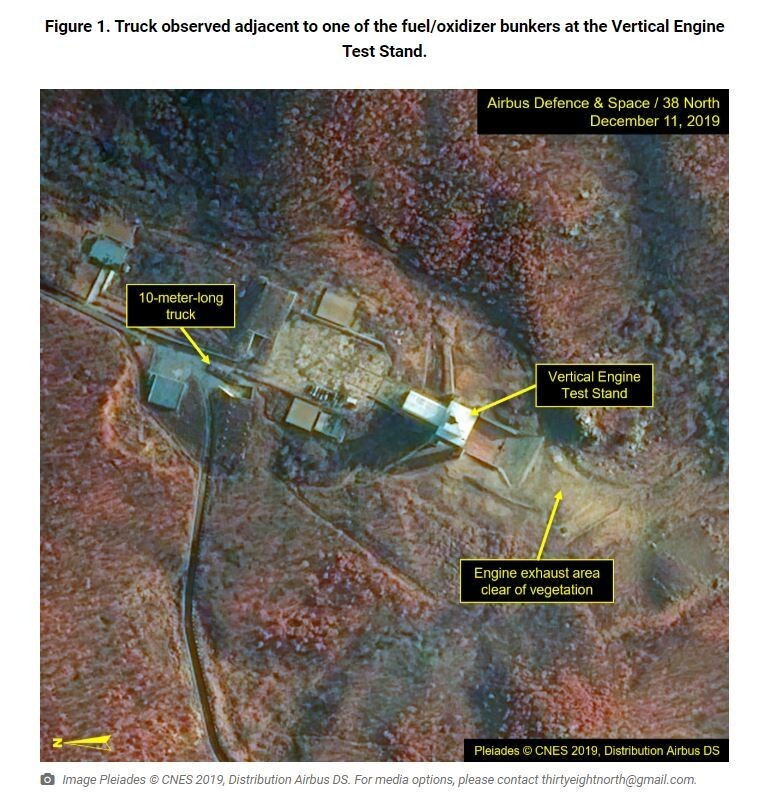hankyoreh
Links to other country sites 다른 나라 사이트 링크
N. Korea holds “crucial test” that lasts for seven minutes at night

North Korea’s Academy of National Defense Science reported on the afternoon of Dec. 14 that it had carried out “another crucial test [. . .] at the Sohae Satellite Launching Ground,” a site in Tongchang Village that also tests missile engines, on the evening of Dec. 13. North Korea had announced a “very important test” at the same place on Dec. 7, just six days ago. Unlike the previous announcement, the academy took the unusual step of specifying the exact time of the test (from 10:41 to 10:48 pm on Dec. 13). What was North Korea hoping to communicate to the outside world by disclosing a “crucial test” that lasted for seven minutes?
As of the afternoon of Dec. 15, the South Korean military and intelligence agencies hadn’t given the press the results of their analysis of intelligence related to the Dec. 13 test. But their apparent conclusion is that the two tests, on Dec. 7 and 13, were designed to develop a new multistage rocket. Seoul is apparently reserving its judgment about whether the rocket that North Korea is apparently developing will be used to launch an upgraded intercontinental ballistic missile (ICBM) or to launch a satellite. Either of these would technically require two engines.
In a statement, Chief of the General Staff Pak Jong-chon, of the North Korean People’s Army (KPA), said that the “new technologies” used in the tests on Dec. 7 and 13 “will be fully applied to the development of another strategic weapon.”
While North Korea hasn’t released a detailed description or any photos of the process or outcome of these tests, a seven-minute test appears to refer to a missile engine combustion test. In light of these circumstances, experts are leaning toward the possibility that the “new technologies” North Korea tested are a new two-stage liquid-fuel engine, small or medium in size. With a small liquid engine, combustion typically takes 7-8 minutes, though sometimes as long as 10.
Experts analyze second stage engine test for rocketsThe propulsion from the first-stage engine is what lifts a missile off the ground and into the sky. After reaching a high altitude, the missile continues its flight, propelled by the second-stage engine. Generally speaking, first-stage engines don’t burn for seven minutes, given their necessarily massive output. The first-stage engine (called the “Mt. Paektu engine) used in the ICBM fired in 2017 had a combustion time of 200 seconds (that is, 3 minutes and 20 seconds). In light of this, the second engine that North Korea tested is probably a second-stage engine, experts said.
Experts explained that a second-stage engine could burn for as long as seven minutes. For one thing, a second-stage engine’s combustion period is longer than a first-stage engine’s, given lower output; for another, a second-stage engine burns intermittently, being activated and deactivated to adjust its trajectory. These observations apply whether the engine in question is used to launch an ICBM or a satellite.
Considering that North Korea’s Academy of National Defense Science said in its Dec. 14 statement that this test would “be applied to further bolstering [. . . North Korea’s] strategic nuclear deterrent,” this test is more likely to concern an ICBM than a satellite. But technically speaking, this kind of test could be used for both purposes. Given a combustion period of seven minutes, a missile carrying the engine in question would be capable of steadily and continuously transporting several warheads, or a warhead heavier than those on North Korea’s current missiles.
North Korea carried out this test at an unusually late time, around 11 pm, which many experts believe was designed to minimize the risk of the test being exposed to American surveillance and reconnaissance assets. A hard-to-detect late-night test basically shows how North Korea is pressuring the US to change its attitude.
By Noh, Ji-won, staff reporter
Please direct comments or questions to [english@hani.co.kr]

Editorial・opinion
![[Guest essay] Preventing Korean Peninsula from becoming front line of new cold war [Guest essay] Preventing Korean Peninsula from becoming front line of new cold war](https://flexible.img.hani.co.kr/flexible/normal/500/300/imgdb/original/2024/0507/7217150679227807.jpg) [Guest essay] Preventing Korean Peninsula from becoming front line of new cold war
[Guest essay] Preventing Korean Peninsula from becoming front line of new cold war![[Column] The state is back — but is it in business? [Column] The state is back — but is it in business?](https://flexible.img.hani.co.kr/flexible/normal/500/300/imgdb/original/2024/0506/8217149564092725.jpg) [Column] The state is back — but is it in business?
[Column] The state is back — but is it in business?- [Column] Life on our Trisolaris
- [Editorial] Penalties for airing allegations against Korea’s first lady endanger free press
- [Editorial] Yoon must halt procurement of SM-3 interceptor missiles
- [Guest essay] Maybe Korea’s rapid population decline is an opportunity, not a crisis
- [Column] Can Yoon steer diplomacy with Russia, China back on track?
- [Column] Season 2 of special prosecutor probe may be coming to Korea soon
- [Column] Park Geun-hye déjà vu in Yoon Suk-yeol
- [Editorial] New weight of N. Korea’s nuclear threats makes dialogue all the more urgent
Most viewed articles
- 1Behind-the-times gender change regulations leave trans Koreans in the lurch
- 2Yoon’s revival of civil affairs senior secretary criticized as shield against judicial scrutiny
- 3Family that exposed military cover-up of loved one’s death reflect on Marine’s death
- 4Japan says its directives were aimed at increasing Line’s security, not pushing Naver buyout
- 5Unexpected rate of AI development requires timely discussion of side effects
- 6[Guest essay] Preventing Korean Peninsula from becoming front line of new cold war
- 7A breath of fresh air: Innovative architecture in the time of COVID-19
- 8S. Korean first lady likely to face questioning by prosecutors over Dior handbag scandal
- 9Marines who survived flood that killed colleague urge president to OK special counsel probe
- 10Is Japan about to snatch control of Line messenger from Korea’s Naver?